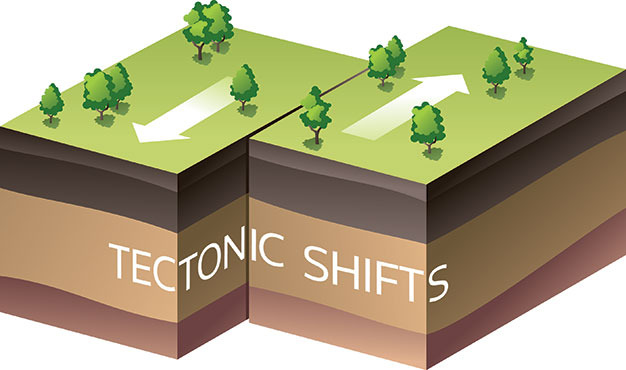Active research is being conducted by scientists to obtain details about the movement of tectonic plates. These movements are responsible for geological events including earthquakes, volcanoes, formation of mountains, sea floor spreading, and island arcs. Most action takes place at plate boundaries.
The Modern Theory of Plate Tectonics

The modern theory of plate tectonics (not “tectonics”) in geomorphology clarifies the geographical processes that occur due to the movement of lithospheric plates above the asthenosphere. The movement of the lithospheric plates is facilitated due to their high strength and low density compared to the layers underneath. The lithospheric plates are composed of crust and the outer layer of the mantle. The crust is sub-divided into the oceanic crust that is thin and dense, and the continental crust that is thick and light. The asthenosphere is the molten, flexible, top segment of the earth’s mantle. The plates move and change their location relative to each other. The relation between the plates and their movements are responsible for the main geological occurrences. The continents gradually shift due to the energy that moves the plates.
The joining location of the plates is known as the plate boundaries. 
These plate boundaries are generally associated with geological events like volcanoes, ocean trenches, earthquakes, and the formation of mountains. Most of the vital volcanoes arise along the plate boundaries. The type of plate boundaries includes the divergent boundary that is under tension and forms the ocean ridges. The collision boundary is under compression, and the transform boundary is experiencing shearing action. Additional oceanic crust is formed at the divergent boundaries, causing destruction of the underneath light continental crust. The momentum of the collision between the crusts causes the formation of mountains and island arcs.

Heat dissipation from the mantle is considered to be the fundamental energy source for tectonic plate movements. The movement of the tectonic plates is facilitated due to the difference in the densities of the oceanic lithosphere and the asthenosphere. Gravitational and frictional forces influence the movement of the tectonic plates. The ocean lithosphere is originally less dense compared to the underneath asthenosphere. However, as the lithosphere is cooled and solidified, its density increases and it sinks into the mantle. This action, or sea floor spreading, provides the main driving force for the plate movements. Seismic tomography reveals the varied distribution of the mantle density that may be due to the rock structures, or the thermal changes due to heat energy. However, the subject of tectonic plate movements and the forces involved is still under active research by geologists and earth scientists.

